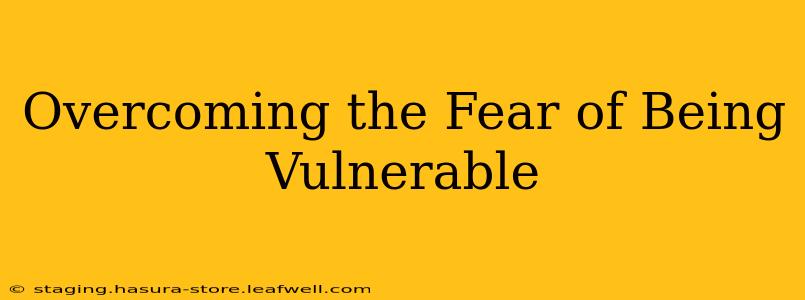Vulnerability. The word itself can evoke a sense of unease, even fear. It conjures images of weakness, exposure, and potential rejection. But what if vulnerability wasn't a weakness, but a superpower? What if embracing our authentic selves, flaws and all, was the key to unlocking deeper connections and a more fulfilling life? This article explores the fear of vulnerability, its roots, and practical strategies to overcome it and cultivate a more courageous and connected existence.
What is Vulnerability?
Before we delve into overcoming the fear, let's define what vulnerability actually means. It's not about weakness; it's about showing up authentically, sharing our true selves—including our imperfections and insecurities—with others. It's about being willing to risk being seen, truly seen, for who we are. This includes sharing our emotions, needs, and experiences, even when it feels risky.
Why Are We Afraid of Being Vulnerable?
The fear of vulnerability is often deeply rooted in past experiences. Negative experiences, such as rejection, betrayal, or criticism, can teach us to protect ourselves by building emotional walls. This protective mechanism, while understandable, can prevent us from experiencing the richness and intimacy that true connection offers.
What are the consequences of avoiding vulnerability?
Avoiding vulnerability can lead to feelings of isolation, loneliness, and a sense of disconnect from others. It can also hinder our personal growth and prevent us from building meaningful relationships. We might find ourselves constantly seeking external validation, never truly feeling seen or accepted.
How to Overcome the Fear of Being Vulnerable
Overcoming the fear of vulnerability is a journey, not a destination. It requires conscious effort, self-compassion, and a willingness to step outside our comfort zones. Here are some practical strategies:
1. Identify Your Fears:
The first step is to understand the specific fears that are holding you back. Are you afraid of rejection? Judgment? Disappointment? Journaling can be a powerful tool for identifying and processing these fears.
2. Practice Self-Compassion:
Be kind to yourself. Recognize that vulnerability is a courageous act, not a sign of weakness. Treat yourself with the same understanding and compassion you would offer a close friend.
3. Start Small:
Don't try to become completely vulnerable overnight. Start with small, manageable steps. Share a personal story with a trusted friend or family member. Express a feeling you've been holding back. Each small act of vulnerability builds confidence and resilience.
4. Cultivate Self-Awareness:
Pay attention to your thoughts, feelings, and physical sensations. Become more aware of your emotional patterns and triggers. This self-awareness will help you identify situations where you tend to shut down and develop strategies for coping.
5. Build Trusting Relationships:
Surround yourself with people who are supportive, accepting, and respectful. These relationships provide a safe space for you to explore your vulnerability and build your confidence.
6. Challenge Negative Thoughts:
When negative thoughts or self-doubt creep in, challenge them. Ask yourself: Is this thought really true? What evidence supports it? What evidence contradicts it? Reframing negative thoughts into more positive and realistic ones is crucial.
What are the benefits of being vulnerable?
Embracing vulnerability can lead to a more authentic and fulfilling life. It allows for deeper, more meaningful connections with others, fostering intimacy and trust. It opens the door to greater self-acceptance and self-compassion. It allows for genuine connection and a stronger sense of belonging.
How can I become more comfortable with vulnerability in romantic relationships?
In romantic relationships, vulnerability is essential for building intimacy and trust. Sharing your feelings, needs, and fears can strengthen your bond with your partner. Start by sharing small things, gradually increasing the depth of your sharing as trust develops. Open communication and mutual respect are key.
How do I know if someone is truly vulnerable with me?
True vulnerability involves sharing authentically, without pretense. It's about showing up as your whole self, including imperfections and vulnerabilities. Look for genuine emotional expression, honesty, and a willingness to be seen. It’s not about grand gestures, but about consistent small acts of trust and authenticity.
Conclusion: Embrace the Power of Vulnerability
Overcoming the fear of vulnerability is a powerful journey of self-discovery and connection. While it can be challenging, the rewards—deeper relationships, greater self-acceptance, and a more authentic life—are immeasurable. By embracing our vulnerabilities, we open ourselves up to a world of possibility and connection. Remember, vulnerability is not weakness; it's courage.

